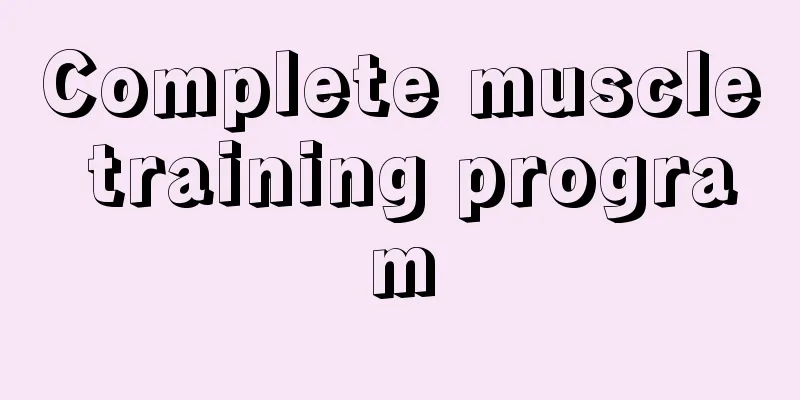Complete muscle training program

|
A complete muscle training plan should first address four issues: arranging training frequency, training parts for each session, using movements for each part, and the weight, number of sets, and rest time between sets for each movement. Only by solving these prerequisites and having an in-depth understanding of all aspects of the body can we build perfect muscles. This is probably what it means to know yourself and your enemy. If you want to succeed in doing things, you must make various plans. If you follow your plans step by step and complete them steadily, you can get the results you want. 1. Schedule the frequency of training The frequency of training is the basis of a training plan. It is necessary to decide how many times to train per week based on many factors such as personal work and rest time, the distance between the gym and home, and the body's recovery ability. In fact, muscle growth is not completely proportional to one's ability to endure hardship. Being too "passionate" and impulsive will increase the probability of injury. Netizens who have read this series of articles should remember that muscles do not grow during training, but grow during the rest between two training sessions. Muscle fibers damaged by training grow through excessive repair, so a certain amount of rest time is necessary. Moreover, if the training frequency is too high, the muscle strength will not be fully recovered by the next training, and the training cannot be carried out in a better state. The effect of the training will be greatly reduced, and you may suffer serious injuries. The recovery time of muscles after sufficient training is generally 48 to 72 hours (not including injuries caused by overtraining). The specific recovery time is roughly proportional to the size of the muscles. For example, large muscle groups such as the back and thigh muscles may sometimes take more than three days to recover; while smaller muscle groups such as the arms and shoulders can recover in about two days. For example, for parts like abdominal muscles and calves, it is generally believed that they do not need to be trained too big, and clear lines are enough. Some bodybuilders even train with a light load once a day just to keep these parts looking good. It should be noted that the muscle recovery time mentioned above is only an approximate time. The specific situation depends on the trainee's physical fitness, genes and the intensity of the last training. Therefore, after formulating a fitness plan, you should also adjust the training frequency and modify the plan in a timely manner based on your feelings after training. No training plan can be used forever. As your body becomes stronger, you should update the training plan at any time. 2. Parts of each training session While exercising the target muscles, auxiliary movements of other muscles are often required. For example, in the training of the pectoralis major, the most "ace" exercise is the bench press, which uses the strength of the triceps and anterior deltoid at the same time. If you plan to train your triceps the day after training your chest muscles, your triceps may already be in a state of fatigue and you will not be able to achieve the training goal. Of course, there are many complex and versatile fitness machines in the gym, and fitness enthusiasts also have a large number of options to isolate and exercise target muscles. Although this is helpful for making plans, it is not conducive to achieving exercise effects, which is a bit of missing the point. Because compound movements, such as squats, deadlifts, bench presses, etc., can not only mobilize multiple muscle groups at once, which has higher training efficiency, but are also more in line with the natural state of human force. By training in this way, the development of muscles will be more balanced. Furthermore, although compound movements must use auxiliary muscles, they can use heavier weights than isolated movements and stimulate the target muscles more deeply. Therefore, when choosing the training area, you should still take the factor of compound movement into consideration, and on this basis, formulate a frequency plan according to the recovery time of each part of the muscle. 3. Actions used for each part After deciding which parts of the body to train each day, athletes usually start their training with compound movements that stimulate the target muscles more deeply, after warm-up exercises. This is to start training with all parts of the body fully energized. If you put isolation movements first, it is very likely that you will not be able to achieve a good training effect because your muscles are already fatigued - note that this is only the usual case - there is a "pre-fatigue" rule in Wade's rule: use isolated movements to fatigue the target muscles in advance, and then use the strength of the auxiliary muscles to do compound movements to completely exhaust the target muscles. This training method is suitable for advanced trainees who need to stimulate specific muscles. Determining the order of compound and isolation movements can only give you a rough arrangement for your training; when it comes to choosing each movement, the difficulty of the movement, the training weight, and the degree of exhaustion are generally used as the basis for selection. 4. Weight, number of sets, and rest time between sets for each exercise Theoretically, the heavier the weight, the deeper the stimulation to the muscles, but this stimulation does not necessarily lead to muscle growth. For example, most people can only complete less than 6 repetitions per set using a certain weight, which makes it difficult to truly exhaust the muscles. That is, because the weight is too heavy, you can’t lift more reps before your muscles become completely fatigued. Moreover, when lifting too heavy a weight, more explosive power is used. Although it can mobilize the muscles to exert greater power, it cannot cause more muscle fiber tears. Therefore, such movements can stimulate strength growth, but have limited effect on increasing muscle volume. In bodybuilding training, the weight for each set of 1 to 6 times is generally called heavy weight. Trainers who want to increase strength can choose such weight. If you choose a weight that can exhaust you after 8 to 12 reps per set, your muscles can reach exhaustion more fully. And because the weight is relatively large and the stimulation to the muscles is deeper, it can usually allow the muscle volume to grow more fully. This weight is called medium weight, and it is also the weight used by most bodybuilders when building muscle. If more than 13 repetitions are required per set, the selected weight is usually relatively small. It is possible that endurance will be insufficient before the muscles are fully stimulated. Such weight is called light weight. Bodybuilders generally use small weights to enhance muscle endurance and cooperate with training during fat loss. Like weight, the total number of sets you use varies from person to person. Generally speaking, after warming up, most people can fully exert their muscles within 3 to 5 sets, and there will be a certain amount of attenuation if they continue. Therefore, it is generally better to arrange 3 to 5 formal groups. Some fitness enthusiasts who are eager for quick results often arrange more sets for themselves, thinking that it will be more effective; in fact, no matter what, the 3 to 5 sets are still the ones that work and are effective. If you want to further increase the training effect, you might as well choose a few different movements to further stimulate the target muscles from other angles. The length of rest between sets should be determined based on the muscle recovery time during training. Some people need several minutes to recover the strength to do the next set after their muscles are fatigued, while others only need a dozen seconds to fully recover. Over time, the muscles will become cooler and the congestion will be reduced, so the strength will decrease. The rest time between sets for the same person also depends on the degree of exhaustion in the previous set and the specific muscle groups. For beginners, you can first determine a rough rest time between sets, and then slowly find the length of time that suits you during training. Beginners should develop a complete muscle training plan under the guidance of professionals. Building muscles is a gradual process and you cannot rush for quick results. The intensity of training should be increased slowly. You should warm up fully before exercise and pay attention to personal safety issues. Then adjust your plan during the exercise process. |
<<: Exercises to burn calories
>>: What are the training methods for leg muscle strength
Recommend
How to train abdominal muscles for fat people
If we are fat people, what methods should we use ...
Is it OK to exercise on an empty stomach in the morning?
Young people like fitness very much. Everyone has...
If you love running, this way of running will destroy your figure
Incorrect running posture not only fails to achie...
How to train deltoids with dumbbells
Dumbbells are a kind of bodybuilding equipment th...
What to do if you gain weight after exercise
In order to lose weight, many people start to &qu...
What causes pain in the groin after breaststroke?
I believe swimming is one of the favorite sports ...
How to use dumbbells to train abdominal muscles?
Abdominal muscles have always been synonymous wit...
What is aerobic exercise for weight loss?
Many friends want to lose weight through exercise...
How to train the deltoid muscles of the shoulders
How can we train good-looking deltoid muscles? It...
What are the ways to do prone barbell rowing?
There are many different ways to row a boat. In a...
If a woman doesn't have a firm body, she won't be able to hold her head up anywhere.
Nowadays, many women are troubled by problems suc...
How to train waist and abdominal muscles?
Nowadays, more and more men pay more attention to...
How to Practice Yoga Ball
Yoga ball is a new type of fitness exercise nowad...
Is doing push-ups regularly effective for losing weight?
You can see a lot of such situations in your dail...
Exercise for blood pressure control
We know that exercise plays a very important role...









